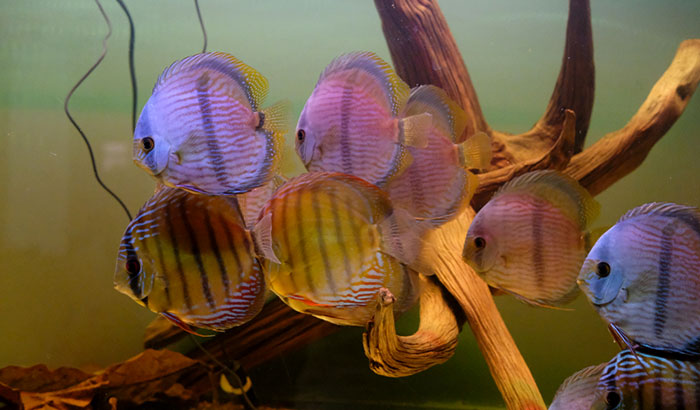Phenols, ammonia, nitrites, nitrates, tannins, and more – many toxic chemicals are harmful to fish. Aquarium hobbyists should effortfully prevent the presence of these harmful substances in their aquariums. In this post, I will focus on how to remove tannins from aquarium water.
I will first discuss what tannins is and how it is made. Then I will explain how harmful it is to aquarium life. Lastly, I will give pointers on how to remove tannins from aquarium water.
Contents
What are Tannins?
Tannins, or tannic acid, are water-soluble polyphenols, which are naturally occurring compounds abundant in plants and historically used for tanning. Their distinct coloring properties are the primary symptom of their presence in an aquarium.
Tannins are abundant in plant life. If aquariums have driftwood in them, as mine do, the tannins in the wood will leach into the water, coloring it yellow or brown.
What are the Effects of Tannins in Water?
Tannins cause the brownish or yellowish tint of aquarium water. The discoloration of water is not a significant problem – it will not harm the fish. However, tannins are usually acidic. They will slowly lower the pH of the water, which can ultimately harm the fish.
While some fish thrive in slightly acidic soft water, like fishes from South America, fishes from the other parts of the world will most likely die in acidic water.
How to Remove Tannins from Aquarium Water
Though the discolored look of aquarium water does not hurt the fish, it takes part of the joy of having an aquarium in the first place. An unclear-looking aquarium prevents me from seeing the full beauty of the fish and some of the plant life. My primary reason for wanting to remove tannins is to see the aquarium in all its glory.
Many items can help remove tannins from an aquarium. My two favorite items are activated carbon and a Seachem product. These two items have different effects. I use either of them, depending on the inhabitants of the aquarium.
What is Activated Carbon?
Activated carbon is perhaps the most well-known filtration media for aquariums. It is made from any carbonaceous material, such as coal or coconut. The carbonaceous material is processed to enhance its absorption and adsorption capabilities.
The most widely used form of activated carbon in aquariums is granular activated carbon (GAC). And the most common carbonaceous material used for aquariums is bituminous coal, more commonly known as black coal.
How Activated Carbon Filters Aquarium Water
Activated carbon has absorption and adsorption properties. Absorption refers to the capacity to trap contaminants within the pores of the filter. Adsorption is the trapping of chemical pollutants by chemically them to the material’s bonding sites.
Activated carbon has both pores and chemical bonding sites. It effectively filters harmful chemicals such as chlorine, phenols, and, you’ve guessed it, tannins. Activated carbon helps remove the yellowish to brownish color in an aquarium. Plus, it will also restore the water’s pH level. I use activated carbon to remove tannins from an aquarium that houses fishes that live in water with a high pH level.
The problem with activated carbon is that it also filters fish medication. So if my fish is sick and I need to give them medicine, I first have to remove the activated carbon filter. But in the grand scheme of things, this is not much of an inconvenience.
Another vital thing to remember about activated carbon is that it requires replacing every month or so. I normally replace my activated carbon filter whenever I clean the gravel of my aquarium – two birds with one stone!
What are Seachem Products?
Seachem is a famous brand of aquarium-related products that every aquarium hobbyist probably knows. They have two products that help combat the discoloring effects of tannins,
Purigen and Renew. However, Renew does not remove the color leached by tannins, so I will focus on Purigen.
Purigen has a different effect from activated carbon. Unlike activated carbon, Purigen does not raise the pH level of the water. Purigen is the perfect choice for an aquarium that houses fishes that thrive in slightly acidic water.
But like activated carbon, Purigen also gets exhausted. After about thirty days, it will stop absorbing and adsorbing foreign pollutants and contaminants in the aquarium.
Final Thought
I like to maintain the clarity of my aquariums. I like seeing the fish and the plant life as clearly as possible. And when tannins get in the way of the aquarium displaying its full majesty, I turn to two items for help.
Activated carbon removes the tannins in an aquarium and raises its pH level. Purigen, on the other hand, combats the discoloration but leaves the pH level alone. I use carbon for aquariums with fishes that thrive in water with a high pH level, while I use Purigen for aquariums requiring slightly acidic water. In my opinion, these two items are the best tools on how to remove tannins from aquarium water.


